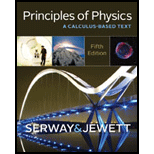
Concept explainers
(a)
The distance of the image of car that is following the person.
(a)
Answer to Problem 22P
The image of the car is at
Explanation of Solution
Given info: The height of the following car is
The rear view mirror is flat plane mirror and for the case of plane mirror the object distance is same as the image distance. Therefore the image distance for the following car is same as the car itself.
Hence, the distance of the car from observer eyes as seen through the flat rear view side mirror is,
Here,
Substitute
Conclusion:
Therefore, the image of the car form the observer’s eye is at distance of
(b)
The angle subtended by the image for the observer.
(b)
Answer to Problem 22P
The angle subtended is
Explanation of Solution
Given info: The height of the following car is
Formula to calculate the angle subtended by the object,
Here,
For the case of plane mirrors the object height and image height are equal and object distance and image distance are equal. Hence, to find the angle subtended by the image of the following car
Substitute
Conclusion:
Therefore, the angle subtended is
(c)
The image distance from the observers eye if the rear view mirror is a convex mirror.
(c)
Answer to Problem 22P
The image is at
Explanation of Solution
Given info: The height of the following car is
Formula to calculate the image distance form a convex mirror for a given object is
Here,
Substitute
Negative
The image distance is negative because the image is formed behind the mirror. Therefore the image distance from the observer’s eye is,
Here,
Substitute
Conclusion:
Therefore, the image of the following car is at
(d)
The angle subtended in the image of view for the observer in the case of convex rear view mirror.
(d)
Answer to Problem 22P
The angle subtended is
Explanation of Solution
Given info: The height of the following car is
From Equation (2) formula to calculate the angle subtended by the image,
Here,
For the case of convex mirrors the object height and image height are not equal.
Formula to calculate the image height is,
Here,
Substitute
From equation (6) and equation (9) respectively, substitute
Conclusion:
Therefore, the angle subtended is
(e)
The distance of the following car based on the angle subtended by the image in the observers eye.
(e)
Answer to Problem 22P
The distance of the following car based on the angular spread in the human eye is
Explanation of Solution
Given info: The height of the following car is
Formula to calculate the angle subtended by the image,
Here,
Substitute
Conclusion:
Therefore, the image appears to be
Want to see more full solutions like this?
Chapter 26 Solutions
Principles of Physics
- A convex mirror with a radius of curvature of 25.0 cm is used to form an image of an arrow that is 10.0 cm away from the mirror. If the arrow is 2.00 cm tall and inverted (pointing below the optical axis), what is the height of the arrows image?arrow_forwardWhat will be the formula for the angular magnification of a convex lens of focal length f if the eye is very close to the lens and the near point is located a distance D from the eye?arrow_forwardA lamp of height S cm is placed 40 cm in front of a converging lens of focal length 20 cm. There is a plane mirror 15 cm behind the lens. Where would you find the image when you look in the mirror?arrow_forward
- Au object of height 3.0 cm is placed at 25 cm in front of a diverging lens of focal length 20 cm. Behind the diverging lens, there is a converging lens of focal length 20 cm. The distance between the lenses is 5.0 cm. Fluid the location and size of the final image.arrow_forwardAn object viewed with the naked eye subtends a 2° angle. If you view the object through a 10 x magnifying glass, what angle is subtended by the image formed on your retina?arrow_forwardIf the lens of a person’s eye is removed because of cataracts (as has been done since ancient times), why would you expect an eyeglass lens of about 16 D to be prescribed?arrow_forward
- Under what circumstances will an image be located at the focal point of a spherical lens or mirror?arrow_forwardShow that, for a flat mirror, hi=ho, given that the image is the same distance behind the mirror as the distance of the object from the mirror.arrow_forwardWhy are diverging mirrors often used for rearview mirrors in vehicles? What is the main disadvantage of using such a mirror compared with a flat one?arrow_forward
- How far should you hold a 2.1 cm-focal length magnifying glass from an object to obtain a magnification of 10 x ? Assume you place your eye 5.0 cm from the magnifying glass.arrow_forwardFor a normal, relaxed eye, a magnifying glass produces an angular magnification of 4.0. What is the largest magnification possible with this magnifying glass?arrow_forwardAn unknown planet at a distance of 1012 m from Earth is observed by a telescope that has a focal length of the eyepiece of 1 cm and a focal length of the objective of I m. If the far away planet is seen to subtend an angle of 105 radian at the eyepiece, what is the size of the planet?arrow_forward
 Principles of Physics: A Calculus-Based TextPhysicsISBN:9781133104261Author:Raymond A. Serway, John W. JewettPublisher:Cengage Learning
Principles of Physics: A Calculus-Based TextPhysicsISBN:9781133104261Author:Raymond A. Serway, John W. JewettPublisher:Cengage Learning Physics for Scientists and Engineers: Foundations...PhysicsISBN:9781133939146Author:Katz, Debora M.Publisher:Cengage Learning
Physics for Scientists and Engineers: Foundations...PhysicsISBN:9781133939146Author:Katz, Debora M.Publisher:Cengage Learning University Physics Volume 3PhysicsISBN:9781938168185Author:William Moebs, Jeff SannyPublisher:OpenStax
University Physics Volume 3PhysicsISBN:9781938168185Author:William Moebs, Jeff SannyPublisher:OpenStax Physics for Scientists and Engineers, Technology ...PhysicsISBN:9781305116399Author:Raymond A. Serway, John W. JewettPublisher:Cengage Learning
Physics for Scientists and Engineers, Technology ...PhysicsISBN:9781305116399Author:Raymond A. Serway, John W. JewettPublisher:Cengage Learning Glencoe Physics: Principles and Problems, Student...PhysicsISBN:9780078807213Author:Paul W. ZitzewitzPublisher:Glencoe/McGraw-Hill
Glencoe Physics: Principles and Problems, Student...PhysicsISBN:9780078807213Author:Paul W. ZitzewitzPublisher:Glencoe/McGraw-Hill




